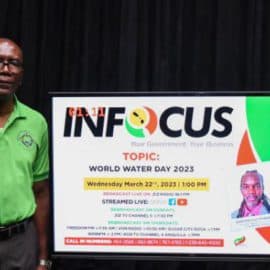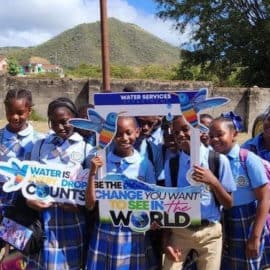
Water is Life and every drop counts. I repeat, Water is Life and every drop counts.
In my capacity as Minister with responsibility for Public Utilities et al which encapsulates the Water Services Department, I wish to provide a statement on the present state of Water Supply across St. Kitts and to bring some much-needed clarity and understanding to our water reality as transparent information on this water issue has been absent in recent years.
After many years of insufficient attention being paid to our water resources, we are now facing a National Water Crisis.
St. Kitts and Nevis is considered a water scarce country based on the UN definition of countries with less than 1000 cubic meters (220,000 gallons) per capita of renewable water resources a year. At present, ALL of our potable water comes from rainfall. That is, when rain falls, there are some rivers that flow moderately and provide surface water and, importantly, water that percolates, mainly along our mountain ranges and along our sloping lands, into our aquifers which provide groundwater. Currently, we have seven (7) rivers providing surface water, which account for about 30% of our water supply, and twenty-six (26) wells providing groundwater, which account for about 70% of our water supply, for a combined production of about 5.6 million gallons of water per day. Water from these sources is channeled or pumped into storage reservoirs ranging in sizes from 20,000 gallons to 1 million gallons. We presently have about 7.5 million gallons of storage. This water is then gravity fed to our homes, businesses, hotels, farms, and the like.
While our present production capacity is 5.6 million gallons per day, our present demand is approximately 6.6 to 7 million gallons of water per day resulting in a deficit of up to 1.4 million gallons per day. Consequently, with a demand greater than production, the Water Services Department is unable to provide 24-hour water supply service in certain areas of St. Kitts. This in turn has resulted in the need for the rationing of our water supply. To compound the issue further, our projected demand for 2025, less than 3 years away, is 8.7 million gallons per day which would represent a deficit of 3.1 million gallons a day based on present capacity to supply.
The question is, why is our production now less than our demand?
Over the past decades, especially during the housing boom in the late 1990s and early 2000s, the standard of living in St. Kitts improved significantly with many more thousands of persons with access to flush toilets and almost every household having a water connection to the public distribution network. The development of a robust public water supply system allowed, at that time, for improvement in farming and other industries. We were only able to meet this upsurge in demand from the rapid housing and tourism expansion and agricultural diversification during that period because we were able to drill new wells around the island.
However, unfortunately, in recent years and in particular the last 7 years, we entered into an era where our ability to meet the ever-increasing demands fell short. Post 2014, the-well drilling program was not sustained as it ought to have been. Additionally, in the absence of well-drilling, there was no aggressive push to find alternative sources.
To compound the issue, over the last 10 years or so, we have recorded a near 20% decrease in annual rainfall thereby causing our aquifers not to adequately recharge even as we pump more and more water from them. Take for instance, over 40 years ago, scientist estimated that the safe yield of the Basseterre Valley Aquifer was 2.5 million gallons per day. However, due to the increased demand and no other sources in the Basseterre area coming on stream, sometimes, in excess of 3 million gallons per day has been extracted from the aquifer. Additionally, with decreased rainfall, it is safe to assume that the safe yield could actually be closer to 2 million gallons a day. Consequently, we have been depleting our aquifer faster than it could recharge. The result is that we are now seeing the signs of saltwater intrusion as our freshwater levels are getting dangerously low. Additionally, as the earth continues to warm due to climate change, we see that our sea water levels are rising which will further impact the rate of saltwater intrusion into our aquifer. Thus, I am advised to warn that if saltwater intrusion is allowed to persist because of over extraction of the wells, our aquifers could be condemned for decades!
Therefore, because of economic expansion leading to increased demand, decreased rainfall, over extraction of our aquifers, signs of saltwater intrusion and little to no exploration of new sources of water over the past 7 years, it became IMPERATIVE to reduce extraction from our aquifers in order to save our aquifers that provide 70% of our potable water. Unfortunately, this has meant that our water supplies have had to be rationed by shutting off reservoirs daily so that they can be partially filled with water for the next day. Additionally, there has also not been enough surface water from our rivers to keep those reservoirs even half full. In short, there is simply not enough water for us to safely produce to meet our current demand, given our current water infrastructure. In most cases when you do not have running water it is because there just is not enough.
I wish to emphasize at this point, that turning on or off water is not like turning on or off electricity. When you turn on electricity, everywhere that is connected to the source receives electricity almost instantaneously. Similarly, when it is turned off, everyone loses it almost simultaneously. However, with water, because of variations in elevations, pipe sizes, pipe distances, pressure, and other factors, water can be turned on and take hours to (or never at all) reach the furthest or highest destination, IF there is enough water to fill all the pipes and home storage tanks along the way. Similarly, when water is turned off, residents at lower elevations could potentially never lose water because all the water does not drain out of the system before the source is turned back on. This is partly why it is difficult to give specific times for all areas as to when water will be go or come. However, there is tremendous room for improvement in communication of information about planned or emergency water outages and as such, efforts are being made for the improved dissemination of water related information from the Water Services Department.
The next question is, where do we go from here?
I want to assure you that as a new administration facing these water challenges which we met, we will not throw our hands up in the air, as it appears our most recent predecessors might have done. We believe in the resilience of our people, hence, together we will come up with solutions that are practical and sustainable. I have every confidence that we will return to 24-hour water supply!
The first low hanging fruit for us to be able to meet our demand, is to reduce our demand and CONSERVE WATER. It is now critically necessary for us to understand the situation and be willing to change our behavior because, unfortunately, we have had a culture of wasting water. This is largely because of the previous abundance of our water supply and its extremely low tariff over the years. Additionally, most of us have grown up being unaware of much of the information which I have just shared in answering the questions of “exactly where does our water come from and how much do we have?” Toward this end, we will be launching a public awareness campaign on our water supply system and the importance of CONSERVATION. The reality is, if all of us were to reduce our water usage by about 20% we would be immediately able to meet the demand. To do this, we would have to fix our leaking faucets and toilets and install water efficient faucets, toilets and appliances where we can; we would have to not be running the water twice as long as is necessary for a shower; we would have to not be using a running hose for the duration of cleaning cars, buildings, etc; we would have to use rainwater harvesting for our irrigation needs for our gardens and lawns as opposed to government supply; just to name a few. In the coming months, the Government will take actions to encourage conservation and strongly discourage wastage. I am therefore appealing to ALL of us to start the practice of water conservation now!
Many people ask the following question: “With all this rainfall that we have had recently, why don’t we capture it in large storage tanks and prevent it from running away to the sea through our ghauts?” Firstly, when rain falls, as much as 80% of it is lost back to the atmosphere through evaporation from the ground and plants. 18% goes into the ground where it becomes groundwater. Only about 2% runs off into the ocean. Let us then say we constructed 7 – one million gallon capacity tanks which we were able to fill after a heavy down pour of rain. By our current demand of roughly 7 million gallons per day, we would consume that water in ONE DAY or, at the very least, a few days if we were to merge it with our present capacity. It would then need to rain every one to three days to keep those tanks filled. Unfortunately, with an increasingly longer dry season and shorter wet season, our rainfall patterns would not be able to constantly fill those tanks. Therefore, one of our major problems is not storage, rather, a major problem is a constant renewable source of potable water.



